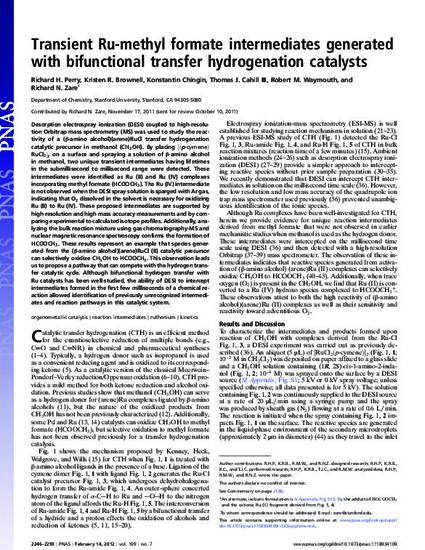
- Organometallic catalysis,
- Reaction intermediates,
- Ruthenium,
- Kinetics
Desorption electrospray ionization (DESI) coupled to high-resolution Orbitrap mass spectrometry (MS) was used to study the reactivity of a (β-amino alcohol)(arene)RuCl transfer hydrogenation catalytic precursor in methanol (CH3OH). By placing [(p-cymene)RuCl2]2 on a surface and spraying a solution of β-amino alcohol in methanol, two unique transient intermediates having lifetimes in the submillisecond to millisecond range were detected. These intermediates were identified as Ru (II) and Ru (IV) complexes incorporating methyl formate (HCOOCH3). The Ru (IV) intermediate is not observed when the DESI spray solution is sparged with Ar gas, indicating that O2 dissolved in the solvent is necessary for oxidizing Ru (II) to Ru (IV). These proposed intermediates are supported by high-resolution and high mass accuracy measurements and by comparing experimental to calculated isotope profiles. Additionally, analyzing the bulk reaction mixture using gas chromatography-MS and nuclear magnetic resonance spectroscopy confirms the formation of HCOOCH3. These results represent an example that species generated from the (β-amino alcohol)(arene)RuCl (II) catalytic precursor can selectively oxidize CH3OH to HCOOCH3. This observation leads us to propose a pathway that can compete with the hydrogen transfer catalytic cycle. Although bifunctional hydrogen transfer with Ru catalysts has been well-studied, the ability of DESI to intercept intermediates formed in the first few milliseconds of a chemical reaction allowed identification of previously unrecognized intermediates and reaction pathways in this catalytic system.
Available at: http://works.bepress.com/richard-perry/10/

©2012 National Academy of Sciences